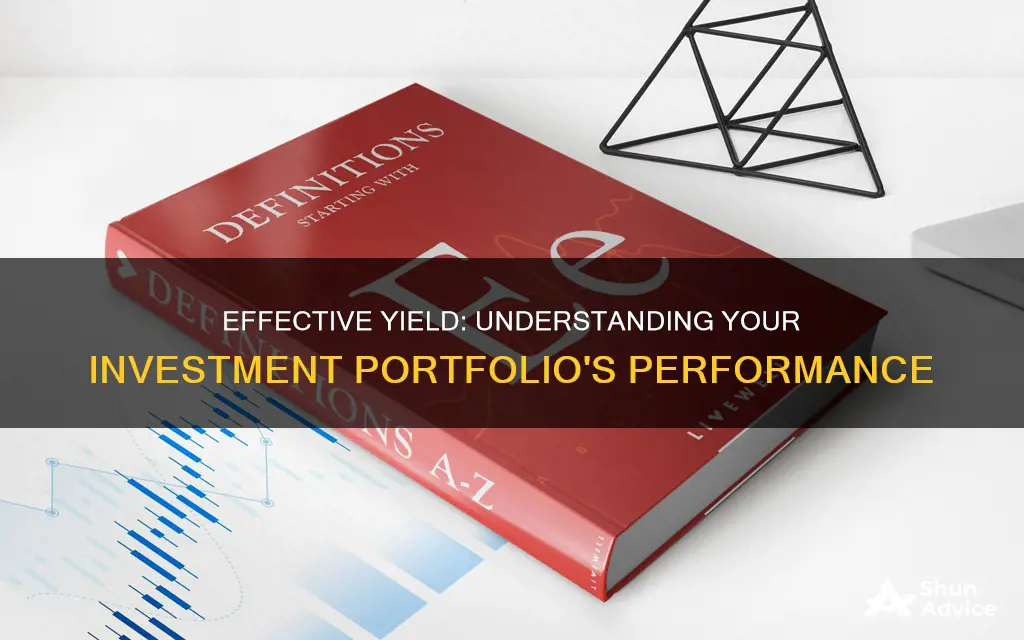
The effective yield of an investment portfolio is a crucial metric for investors to understand, as it provides a more accurate measure of the portfolio's true return. It is calculated by accounting for the effects of compounding interest, giving investors a more comprehensive view of their investment's performance. Unlike the nominal yield, which is the stated interest rate of the bond's coupon, the effective yield considers how often interest is applied to the principal within a year. This is particularly important for investments where interest compounds more frequently than annually. By understanding the effective yield, investors can make more informed decisions about their investment portfolios and maximise their returns.
| Characteristics | Values |
|---|---|
| Definition | The expected effective yield of an investment portfolio is the anticipated return on the portfolio, including the impact of compounding interest. |
| Formula | Effective Yield = (1 + i/n)ⁿ – 1, where ‘i’ is the nominal interest rate and ‘n’ is the number of compounding periods per year |
| Comparison to Nominal Yield | Effective yield is higher than nominal yield due to the compounding effect. |
| Reinvestment Assumption | Effective yield assumes that coupon payments are reinvested at the same rate. |
| Impact on Bond Management | Effective yield is a crucial metric for evaluating bond investments and optimizing a bond portfolio to meet specific investment goals. |
| Tax Implications | Different types of bonds have varying tax treatments, which can significantly impact the effective yield. |
| Risk Assessment | Higher expected returns often come with increased risk. |
| Portfolio Construction | Expected returns guide the allocation of capital across different assets in the portfolio. |
| Goal Setting | Expected returns help align investment strategies with financial objectives. |
| Performance Evaluation | Expected return serves as a benchmark to measure the actual performance of the portfolio. |
What You'll Learn

Effective yield vs. yield-to-maturity
The effective yield and yield-to-maturity (YTM) are two important concepts in finance and investment that help investors understand the potential returns on their bond holdings. While both measures reflect the expected returns from a bond, they differ in their calculation methods and assumptions, providing investors with different perspectives on the bond's performance.
Effective Yield:
The effective yield represents an investor's total return on a bond when the interest payments, also known as coupons, are reinvested at the same interest rate. It takes into account the compounding effect on investment returns, providing a more comprehensive measure of the actual yield received by the investor. The formula for calculating the effective annual yield (EAY) is:
> EAY = (1 + (r/n))^n - 1
Where "r" is the nominal rate or annualised rate of return, and "n" is the number of compounding periods within a year. This formula assumes that interest or investment gains are compounded at regular intervals throughout the year.
Yield-to-Maturity (YTM):
The YTM, on the other hand, represents the rate of return obtained on a bond if it is held until its maturity date. YTM describes the average yield or return that an investor can expect from a bond if they purchase it at its market value and hold it until maturity. This value is determined using the coupon payment, the value of the bond at maturity, and any capital gains or losses incurred during its lifetime. To compare the effective yield and YTM, the YTM needs to be converted into an effective annual yield.
Comparing Effective Yield and YTM:
The comparison between effective yield and YTM provides valuable insights into bond pricing and market positioning. Bonds with an effective yield higher than the YTM typically sell at a premium, while those with a lower effective yield trade at a discount. This relationship helps investors understand the relative value of a bond in the market.
In summary, the effective yield and YTM are both important measures for assessing the potential returns on a bond investment. The effective yield considers the compounding effect of reinvested interest payments, while the YTM focuses on the average return over the bond's lifetime. By comparing these two measures, investors can make more informed decisions about the pricing and expected returns of their bond holdings.
Building an Australian Investment Portfolio: Strategies for Success
You may want to see also

How to calculate effective yield
The effective yield of an investment portfolio is a nuanced measure that takes into account the effects of compounding interest, providing a comprehensive view of the portfolio's return. It is calculated as the total yield an investor receives, in contrast to the nominal yield, which is the stated interest rate of the bond's coupon. Effective yield assumes that coupon payments are reinvested, and it takes into account the power of compounding on investment returns.
To calculate the effective yield, you need to understand the formula: Effective Yield = (1 + i/n)ⁿ – 1, where 'i' represents the nominal interest rate and 'n' denotes the number of compounding periods per year. For instance, if an investment offers a nominal interest rate of 6% compounded quarterly, the effective yield would be calculated by dividing the annual rate by the number of compounding periods (6%/4), adding one to this quotient, raising it to the power of the number of periods (4), and then subtracting one. This results in an effective yield of approximately 6.14%, slightly higher than the nominal rate due to the compounding effect.
It is important to note that effective yield is different from the current yield, which represents a bond's annual return based on its annual coupon payments and current price, rather than its face value. Effective yield also assumes that coupon payments can be reinvested in another vehicle paying the same interest rate, which may not always be possible due to changing interest rates.
When calculating the effective yield of an investment portfolio, it is crucial to consider the frequency of compounding. The more frequently interest is compounded, the higher the effective yield will be. Additionally, the prevailing interest rate environment, credit quality of the issuer, and inflation can all impact the effective yield.
By understanding how to calculate effective yield, investors can make more informed decisions about their investment portfolios and maximize their returns.
Investing vs. Saving: Brainly's Guide to Financial Strategies
You may want to see also

Factors influencing effective yield
The effective yield of an investment portfolio is influenced by several factors that can significantly impact the returns. Here are some key factors to consider:
Frequency of Compounding
The frequency of compounding directly affects the effective yield. When interest is compounded more frequently, the effective yield increases. For example, an investment with monthly compounded interest will yield more over the same period compared to an investment with annual compounding, assuming the same nominal interest rate. This is because each compounding period adds interest to the principal, which then earns interest in subsequent periods.
Prevailing Interest Rate Environment
Market conditions, such as rising or declining interest rates, impact the yields of newly issued bonds and fixed-income securities. During a rising interest rate environment, these securities tend to offer higher yields to attract investors. On the other hand, in a declining interest rate environment, the yields on new issues will generally be lower. Investors need to consider these market dynamics when deciding on the timing of buying or selling their holdings.
Credit Quality of the Issuer
The credit quality of the issuer plays a crucial role in determining effective yield. Higher credit quality usually indicates lower risk but often results in lower yields. Conversely, lower credit quality issuers may offer higher yields to compensate for the increased risk of default. Investors must carefully assess the potential for higher returns against the risk of losing their principal investment. Credit ratings from agencies like Moody's or Standard & Poor's can provide valuable insights into the creditworthiness of issuers.
Inflation
Inflation erodes the purchasing power of future interest payments, effectively reducing the real yield of an investment. To mitigate this, investors may consider inflation-protected securities, such as Treasury Inflation-Protected Securities (TIPS), which adjust the principal based on inflation rates. These securities can help maintain the effective yield in real terms, providing a hedge against inflation.
Interest Rate Risk
Changes in interest rates can significantly impact the effective yield, especially for long-term investments. To manage this risk, portfolio managers often employ strategies such as laddering, where bonds with staggered maturities are purchased. This ensures that a portion of the portfolio matures regularly and can be reinvested at current interest rates, stabilising the effective yield over time.
Are 5% Monthly Investment Portfolio Gains Achievable?
You may want to see also

Effective yield in bond management
Effective yield is a financial metric that measures the interest rate, or coupon rate, return on a bond. It is a more accurate investment return metric than the nominal or simple yield metric because it takes compounding into consideration.
The effective yield is the total yield an investor receives, in contrast to the nominal yield, which is the stated interest rate of the bond coupon. Effective yield assumes coupon payments are reinvested, which means the effective yield of a bond is higher than the nominal yield. Effective yield also takes into account the power of compounding on investment returns, while nominal yield does not.
The formula for calculating the effective yield on a bond purchased is:
Effective Yield = [1 + (i/n)]n – 1
Where:
- I = the nominal interest rate on the bond
- N = the number of coupon payments received in each year
For example, if an investor purchases a bond with a nominal coupon rate of 7% and receives coupon payments twice a year, the effective yield calculation is:
[1 + (.07/2)]2 – 1 = 7.123%
If the same investor instead receives 12 monthly coupon payments, the calculation is:
[1 + (.07/12)]12 – 1 = 7.229%
The higher resulting effective yield shows the benefit of more frequent compounding of interest for investors.
Effective yield is often contrasted with the nominal yield metric, or with the bond equivalent yield, which is a measure applied to zero-coupon bonds.
The effective yield of a bond is one of several ways to evaluate its potential risk and return. Other methods include the running yield, nominal yield, yield to maturity (YTM), yield to call (YTC), and yield to worst (YTW).
Robinhood Investing and Portfolio Management: A Beginner's Guide
You may want to see also

Tax implications of effective yield
When it comes to investing, taxes can be one of the biggest expenses. Understanding the tax implications of effective yield is crucial for investors aiming to maximise their after-tax returns and make informed decisions. Here are some key considerations:
Different Types of Bonds and Their Tax Treatments:
The type of bond you invest in can have a significant impact on your tax obligations. For example, interest income from corporate bonds is typically subject to federal, state, and local taxes, which can reduce your effective yield. On the other hand, interest from municipal bonds is often exempt from federal taxes and, in some cases, state and local taxes if you reside in the issuing state. This tax advantage makes municipal bonds particularly attractive as they may offer a higher effective yield after taxes compared to taxable bonds with similar nominal yields.
Tax-Deferred Accounts:
Individual Retirement Accounts (IRAs) and 401(k) plans are examples of tax-deferred accounts. Investments held within these accounts grow tax-deferred, meaning you postpone paying taxes on interest income and capital gains until you make withdrawals. While this can enhance your effective yield over time due to the power of compounding, it's important to consider the tax rate at the time of withdrawal, as it could be higher or lower than the current rate, impacting your overall return.
Capital Gains Taxes:
When you sell an investment for a profit, you may be subject to capital gains taxes. The rate you pay depends on how long you held the investment. For assets held for more than a year, the capital gains tax rate is typically 0%, 15%, or 20%. For assets held for a year or less, you pay taxes based on your ordinary income tax bracket. A strategy called tax-loss harvesting can help minimise capital gains taxes by using losses to offset gains.
Dividend Taxes:
Dividends are usually taxable income, and the rate you pay depends on whether they are qualified or non-qualified. Non-qualified dividends are taxed as regular income, while qualified dividends are typically taxed at a lower rate of 0%, 15%, or 20%, depending on your income and filing status. Holding dividend-paying investments inside a retirement account can be a way to defer taxes.
Mutual Fund Taxes:
Mutual funds may generate taxes on dividends and capital gains while you own the fund shares, as well as capital gains taxes when you sell the shares. Holding mutual fund shares inside a retirement account could defer these taxes. Additionally, choosing funds less likely to distribute taxable income can help minimise taxes.
Tax-Efficient Investing Strategies:
To minimise taxes, investors should consider holding tax-efficient investments in taxable accounts and less tax-efficient investments in tax-advantaged accounts. Taxable accounts, such as brokerage accounts, offer more flexibility but are subject to different tax rates depending on how long you hold an asset before selling it. Tax-advantaged accounts like IRAs and 401(k)s have tax benefits but come with annual contribution limits and restrictions on withdrawals.
Diverse Portfolios: Smart Investing for Long-Term Success
You may want to see also
Frequently asked questions
The effective yield is the return on a bond that assumes the interest payments (coupons) are reinvested at the same rate by the bondholder. It is a more accurate measure of an investment's true return as it accounts for the effects of compounding interest.
The effective yield is calculated using the formula: Effective Yield = (1 + i/n)^n – 1, where 'i' is the nominal interest rate and 'n' is the number of compounding periods per year.
Nominal yield is the stated interest rate of a bond's coupon. It does not take into account the impact of compounding on investment returns, unlike effective yield. Effective yield is usually higher than nominal yield due to the compounding effect.
Effective yield is crucial in investment decision-making, especially for bonds. It provides a more comprehensive view of an investment's return, allowing investors to compare different options effectively.
Effective yield is a key metric for evaluating bond investments. Portfolio managers consider effective yield along with other factors like duration, convexity, and interest rate risk to optimize the overall bond portfolio and meet specific investment goals.







